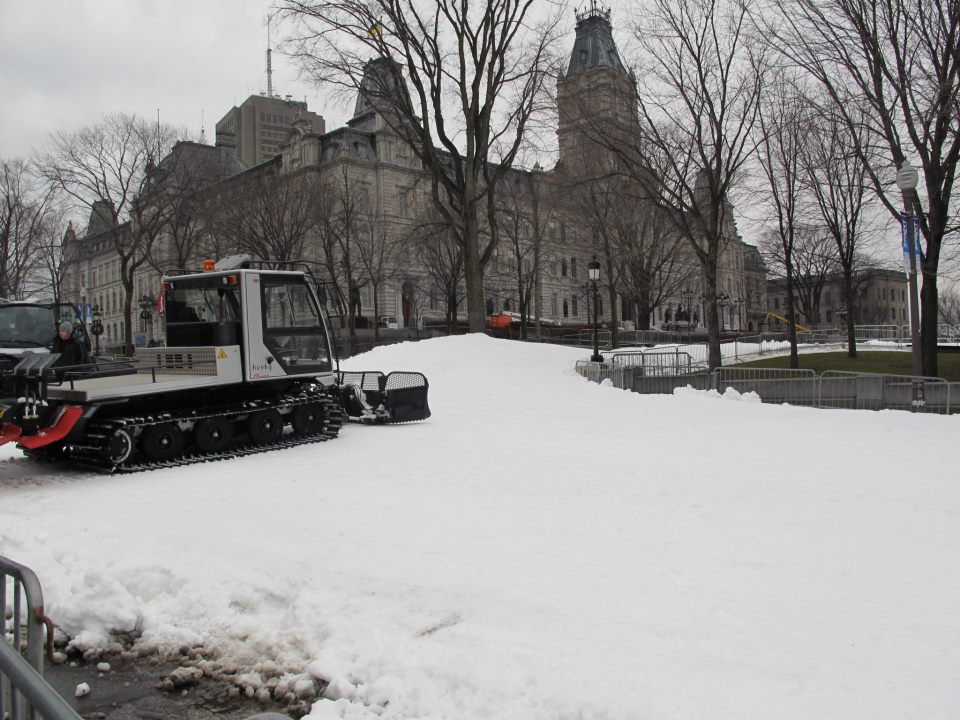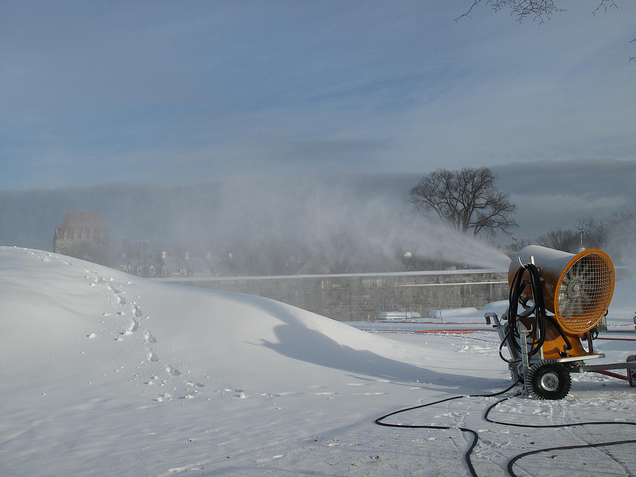
Québec’s seen pretty much everything when it comes to sporting events, from Mountain Bike World Championships to Red Bull Crashed Ice and a transoceanic sailing race known as the Transat Québec Saint-Malo. Gestev, an event-production company based in Québec City, hosted them all, but cross-country skiing city sprints? That was a new one.
So was the idea of spreading 10,000 cubic meters (353,000 cubic feet) of snow over some of the provincial capital’s busiest streets. Last weekend, that number was up to 12,000 cubic meters (nearly 424,000 cubic feet).
In a phone interview on his way back from a Crashed Ice event in Niagara Falls on Sunday, Gestev president Patrice Drouin was shifting gears from the full-contact hockey/downhill skating/boardercross competition, to what was waiting for him in Québec City.
On Saturday, sixty employees and dozens more volunteers started laying down the 850-meter sprint course with extra snow to work with as a result of cold temperatures (racers will do two loops for 1.7 k). Two snow guns on the nearby Plains of Abraham and two more on Parliament hill had been churning out the white stuff since Nov. 6.

Organizers produced and stockpiled more (5,000 cubic meters) just in case at the Mont Sainte-Anne nordic area 45 minutes northeast of the city. As of Sunday, Drouin said they didn’t need it with more than 80 percent of the course sufficiently covered. With extra snow to work with, they made Parliament hill a little steeper.
“We could’ve done the track with less than that, 6,000 to 7,000 meters,” Drouin said. “But because the weather was good, we could produce snow in a matter of hours.”
They took that window and ran with it, and despite light rain falling on Sunday and above-freezing temperatures expected throughout the week, Drouin said they weren’t concerned.
“That doesn’t affect the snow at all,” he said. “The mechanical snow that we produce is so hard and so dense … [the rain] makes the snow more compact.
“I am very impressed to see the quality of the track,” he added. “I’ve been to Düsseldorf [Germany] and our snow compared to Düsseldorf is much better. It’s exactly I think what you want to get as far as snow quality.”
With three loaders transporting 90 truckloads onto the course and two snowcats grooming around the clock, Drouin said all but Grande Allée had been covered by Sunday. That was planned for late Tuesday night (for a webcam update, click here). From there on out, the main road in front of the Parliament Building would be closed, essentially shutting down the city centre adjacent to the Old City for the rest of the week.
Meanwhile, the province’s legislature would still be in session. Sprint Québec organizers agreed to adhere to noise restrictions on Friday morning during National Assembly meetings, but as of noon, all systems were on (the team freestyle sprints start at 2 p.m.).
“It’s a long process but when we presented the project to the city, they were really keen on doing it,” Drouin said. “When we had the first meeting with the city we got full support.”
Gestev’s reputation in its home city helped, he said. In past events, they’ve been respectful of permits, tried not to take up much space or make too much noise. But with heavy machinery and more than 50,000 spectators expected for the two-day International Ski Federation (FIS) Cross-Country World Cup on Friday and Saturday, this was going to be entirely unprecedented.
Never before has a World Cup city sprint been held in North America, and this marks the first nordic World Cup in the eastern part of the continent.
Drouin said the project, estimated at $2.5-million dollars, has been a challenge, but that’s what makes it exciting.
“Cross-country skiing at such a level with the best in the world at the sprint format, that will be amazing right downtown so we sold it that way,” he said. “It will be the first time that the [Québec] population will see cross country in that way, big, and the exchange and the action that sprints provide.”
Cross-country skiing is already popular in Québec, and the city has been making an effort to promote the lifestyle sport with trail-building projects and other initiatives. So when Drouin pitched the idea, the city jumped on board.
“It’s a healthy sport, attracts a lot of people in the Québec area and plus we have the Alex Harvey factor,” he said of Québec’s own national team member. “We have this young athlete that has done very well, but has a nice personality as well.”
His father, Pierre, is the honorary president of the event. Drouin said the location, with a chance to showcase historic Québec, and the challenge of hosting cross-country ski races in December made it appealing.
“We can officially say today that we will succeed in delivering the event,” Drouin said. “That was a challenge people were so worried [about] making snow. … That will make a difference and people will come.”
As of Tuesday, 136 athletes from 17 different nations were registered for the freestyle sprints. According to a press release, more 300 volunteers, 200 journalists and 160 paid workers are expected for the event.
***
Related: Quebec Ready for First World Cup; Harvey Shows Support
Alex Kochon
Alex Kochon (alexkochon@gmail.com) is a former FasterSkier editor and roving reporter who never really lost touch with the nordic scene. A freelance writer, editor, and outdoor-loving mom of two, she lives in northeastern New York and enjoys adventuring in the Adirondacks. She shares her passion for sports and recreation as the co-founder of "Ride On! Mountain Bike Trail Guide" and a sales and content contributor at Curated.com. When she's not skiing or chasing her kids around, Alex assists authors as a production and marketing coordinator for iPub Global Connection.

2 comments
sportalaska
December 5, 2012 at 2:56 pm
Unless my Excel software isn’t functioning properly, and unless my memory regarding the length of a meter in inches is faulty, the ratio of cubic feet to cubic meters is in excess of 35:1, so 10,000 cubic meters of snow is actually more than 350,000 cubic feet of snow. That is a LOT. Cubic yards to cubic meters is 1.3:1, so 10,000 cubic meters is 13,000 cubic yards. Many dump-truck loads!
Alex Matthews
December 5, 2012 at 3:51 pm
You’re right! Thanks for catching that. Makes a BIG difference.